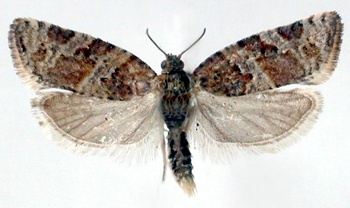Pests
Argyrotaenia ljungiana (Thunberg) - Grape Tortrix
Systematic position.
Class Insecta, order Lepidoptera, family Tortricidae, subfamily Tortricinae, tribe Archipini, genus Argyrotaenia.Synonyms.
A. pulchellana Hw., Tortrix politana Hw., Eulia politana Hw.Biological group.
Polyphagous pest of fruiters, field and subtropical crops.Morphology and biology.
Forewings variable in color, from gray to red-brown with dirty-yellow or reddish median and tornal bands (wingspan 13-14 to 16-18 mm). Hindwings brownish-gray or gray, with broad grayish fringe. Caterpillar green, shining, translucent, with finely shagreenate skin, 12 mm in length. Head and thoracic legs yellow. Pupa brown, 6-9 mm in length. Cremaster with short hooked setae, of which 4 are attached at rounded apex in a transverse row and one pair before apex on each side. Pupae winter in bark crevices of trunks and thick branches and within litter on field cultures and in northern areas. Females lay 45-200 eggs by groups on the upper side of apple leaves. Egg batches are covered by a meshed membrane, usually oriented along leaf ribs. Each batch contains 4 to 150, with an average 30-50 eggs; the first batch contains more than 30 eggs. Eggs develop 4-5 days under optimum conditions. On apple trees, the 1st-2nd instar caterpillars skeletonize and eat away parenchyma of two plaited leaves. Beginning from the 3rd instar, they live in rolled or folded leaves and damage seed-buds or fruits adjoining to those leaves, gnawing out surface cavities in fruits. Beginning with the 4th instar, they gnaw out deeper pits and cavities. The caterpillars gnaw through vessels of bunches on grapes, promoting shrinkage of berries. Caterpillars of the 1st and 2nd summer generations pupate in silky cocoons between plaited leaves in places of their feeding. Pupae develop for 7-10 days. Caterpillars of wintering generation pupate in cocoons in bark crevices of trees or in litter layer.Distribution.
The species occurs in the Western Europe (except for the Far North), in Asia Minor, Mongolia, China, Japan, Northern America. In the former USSR, it is distributed in the European part (from Baltics, Karelia and Leningrad Region to the Caucasus), in Transcaucasia, in southern Kazakhstan, Central Asia (Tadjikistan, Uzbekistan, Kirghizia), locally at the Ural, in western and southern Siberia, and in the Far East (Amur Region, the south of Khabarovsk Territory).Ecology.
The species has 1-2 generations per year in northern half of the European part and 2-3 in Transcaucasia. In spring, pupal development termination requires 13-20 days with average daily temperature 11-12°C. In Transcaucasia, moth flight begins just before flowering of mid-season apple varieties, having peaks in April-May, then in July and September. The moths are active at night and evening when females eat the nectar of small flowers. The developmental period of 1st generation is 40-45 days, the 2nd is 20-25, and the 3rd is 80-85 days. Optimum conditions for the development of all stages are temperatures 22-28°C and relative air humidity 70-80%; the lower threshold of the development of eggs is about 15°C. Hatching caterpillars creep away almost immediately at a speed of 2 m/h, spread on silky threads by the wind. The caterpillars of wintering generation pupate in September-October. Species of the family Braconidae parasitizes on the caterpillars.Economic significance.
The pest is significant for fruiters, industrial, ornamental, and field cultures in the south of the European part of the former USSR and in Transcaucasia. Strong harm is recorded for grapes, apricot, citrus crops, kenaf, to a lesser degree for caraway, chrysanthemum, string bean, lavender, corn, and even coniferous plants. In addition, caterpillars meet on plants of the families Asteraceae, Ranunculaceae, Ericaceae etc. In the southern part of its area, the caterpillars of different generations develop on different host plants. Despite polyphagy of the caterpillars, females prefer apple trees and tea bushes for egg laying. The 2nd generation is the most dangerous for apple, and 3rd for grapes. In Azerbaijan, the caterpillars can damage 20-47% of apples of late varieties; in Georgia, they can destroy 40% of tea leaves; and at the pest mass reproduction, the tea bushes can become naked. Control measures. Agronomical ones include cleaning of trunks and cutting of branches. Biological measures include application of Trichogramma for eggs and biological preparations for caterpillars. Chemical ones are insecticide treatments against hatching caterpillars in the centers populated with the pest. Monitoring is possible by use of sex pheromone traps.Reference citations:
Arnol.di, L.V., ed. 1960. Insect pests of maize in the USSR: handbook. Moscow & Leningrad: AN SSSR, 228 p. (in Russian).Kostyuk, Yu.A. 1974. Family Tortricidae. In: Vasil.ev, V.P., ed. Pests of agricultural crops and forest plantations. V.2. Arthropods. Kiev: Urozhai, p. 261-320 (in Russian).
Kostyuk, Yu.A. 1980. Tortricidae. Iss. 10. Tortricinae. In: Dolin V.G., ed. Fauna of Ukraine, V. 15. Kiev: Naukova dumka. 424 p. (in Ukrainian).
Kuznetsov, V.I. 1994. Family Tortricidae. In: Kuznetsov, V.I., ed. Insects and mites . pests of agricultural plants. V. 3(1). Lepidoptera. St.Petersburg: Nauka, p. 51-234 (in Russian).
Kuznetsov, V.I. 2001. Family Tortricidae (Olethreutidae). In: Ler, P.A., ed. Keys to the insects if the Russian Far East. V. 5(3). Trichoptera and Lepidoptera. Vladivostok: Dal.nauka, p. 11-472 (in Russian).
Milyanovskii, E.S. 1955. Adaptability of local insect species to introduced subtropical plants under conditions of damp subtropics of the Black Sea coast. Zoologicheskii zhurnal 34(1): 101-111 (in Russian).


